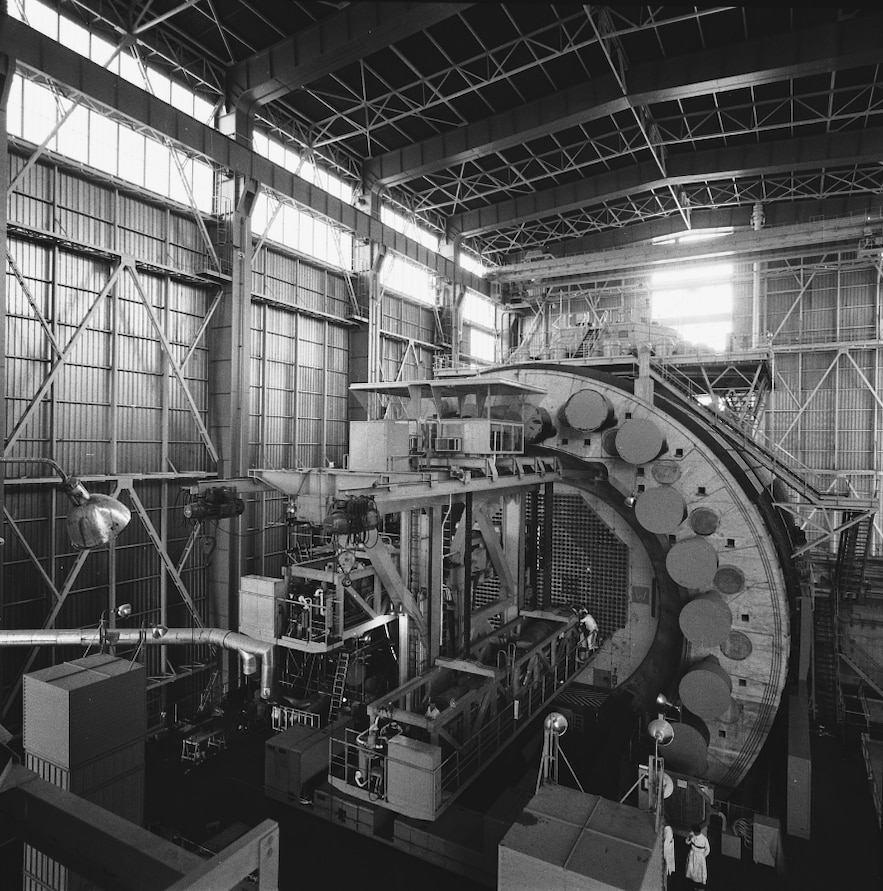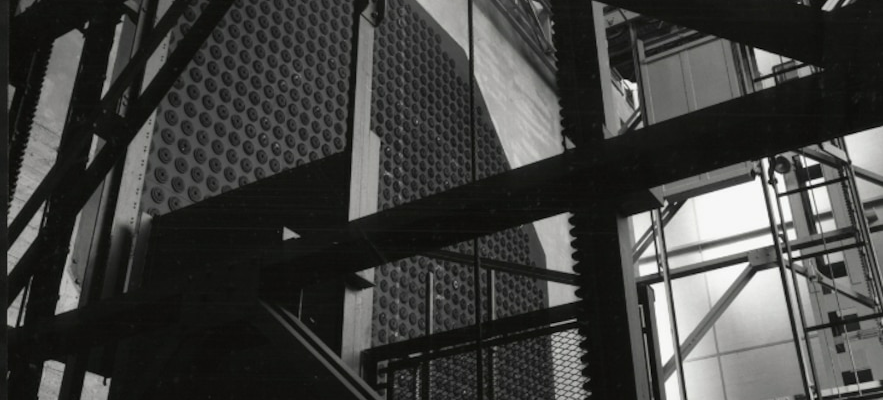Headquarters, factories, stores, these places constitute the starting points of some of the greatest French industrial and commercial sagas. In this summer seriesL’Express opens the doors to emblematic sites that have marked the country’s economic history.
EPISODE 1 – Renault: the true story of Building X, where it all began
EPISODE 2 – Carrefour: the little-known story of France’s first hypermarket
When the television cameras entered the Marcoule site in 1956, the largest industrial project in the Rhone Valley still looked like a huge construction site. Along the dirt paths, workers with trowels passed scientists in white coats, under the stern gaze of the police equipped with caps stamped “CEA”, the Atomic Energy Commission. In this setting under construction, a strange circular tower 100 meters high immediately attracted attention. This was the cooling air exhaust chimney for the G-1 atomic pile.
“Officially, the decision to create the site in the early 1950s was in response to civilian needs. The idea was to produce plutonium there, which would serve as fuel for the reactors of the future,” explains Michaël Mangeon, associate researcher at the Interdisciplinary Research Laboratory for City, Space, Society (Rives) at the University of Lyon. But at the time, experts were well aware that this material could also be used to make bombs. “In 1945, from its creation, the CEA was intended to conduct research in the military field to equip France with the bomb as soon as possible. General de Gaulle had clearly understood that a non-nuclear power would be ‘out of the game’ in international relations. It was therefore not a question of pride or a desire for military power. It was about being heard at the UN Permanent Council,” recalls historian Alain Beltran. G1, which started in January 1956, would therefore produce the plutonium for the first French nuclear bomb, Gerboise bleue, which exploded in the Algerian Sahara desert on February 13, 1960. To support it, a plutonium extraction plant (UP1), a pilot reprocessing workshop (APM) and two other reactors (G2 and G3) also emerged.
The G1 reactor on the CEA Marcoule site in 1958. Natural uranium was introduced into the reactor through this loading face
© / P. Jahan/CEA
It was in this very military context that the first electrons for civilian purposes were produced. “We knew that we could produce electricity from an atomic pile. The English and the Americans had succeeded in doing so,” explains Alain Beltran. This avenue interested EDF, which had just been created. But it was not competitive at the time, due to the low price of fossil fuels such as coal and oil. And then, relations with the CEA were rather cold. The CEO of EDF at the time summed up the differences of opinion between the two companies: “The CEA was aiming for the Nobel Prize, EDF the price per kilowatt hour.”
The time of “all oil”
In 1954, a memorandum of understanding between the two entities was nevertheless signed. The idea? To try to produce electricity from the G1 reactor. “It was a small EDF installation grafted onto the CEA’s G1 reactor, to recover the heat and then transform it into electric current,” says Michaël Mangeon. The experiment took place on September 28, 1956. It did not go quite as planned. The temperature did not reach the hoped-for 180 °C, but only 150 °C. The system therefore produced fewer kWh than expected. A historic milestone had nevertheless just been reached. “Our country, where the first nuclear patents were filed in 1939, but which then found itself left behind during the Second World War, began, in 1956, the considerable effort that would make it fifty years later the world leader in nuclear power”, recalls Rémy Carle, former director of reactor construction at the CEA, in an archive interview.
Fifteen years later, the Marcoule site became the scene of a second feat. That of the construction of a “breeder” reactor capable of producing its own fuel while operating. Named Phénix, this industrial demonstrator with a power of 250 megawatts of electricity was connected to the network in December 1973, only five years after the start of work! “It was the time of ‘all oil’, but at what price since the ‘shock’ of October! We can therefore understand the importance given at this precise moment to the start-up of a new technology nuclear power plant benefiting from high thermal performance, close to that of fuel oil installations, with better efficiency, all while being a breeder, that is to say producing more fuel than it consumes!” emphasize former Phénix managers, on the website of the French Nuclear Energy Society (SFEN).

The G2 reactor at the CEA Marcoule site in 1958. Natural uranium was fed into the reactor through this loading face. G2 produced the first nuclear electric megawatts on the grid
© / P. Jahan/CEA
The facility will operate for thirty-five years. Its final shutdown will be pronounced in 2009 by the safety authorities, due to uncertainties related to its aging. “But at the end of its long operating career, the Phénix reactor has left a considerable amount of knowledge as a legacy. Above all, it has made it possible to experimentally demonstrate the possibility of breeding and even to provide a measurement of it. This is, to date, a unique result in the world on this scale,” says Dominique Grenêche, a doctor in nuclear physics and member of the NGO PNC-France (Nuclear Heritage and Climate).
The era of extractive chemistry
Today, Marcoule has turned the page on its past exploits. The 800 square meters that housed the G1 nuclear reactor are now occupied by an information space. The Phénix reactor, meanwhile, is being dismantled. A process that should take several decades. “One of the specificities of this type of reactor is the presence of sodium, a metal that can ignite on contact with air and generate hydrogen in the presence of water. For Phénix, this represents 1,500 tons of sodium to be treated, drained and transformed,” they emphasize at the Institute for Radiological Protection and Nuclear Safety.
Deprived of a reactor, Marcoule is still looking to the future. “Apart from research into fuels – Orano manufactures its famous Mox on site – we do a lot of extractive chemistry,” confirms a CEA manager. And this, with the aim of recovering, within the waste from the sector, extremely precious materials such as ruthenium, a rare metal very resistant to extreme temperatures, or rhodium, which resists corrosion and whose prices can reach several hundred thousand euros per kilo! In Marcoule, the nuclear sector is also participating in the growth of renewable energies since the CEA is working on the recovery of components used in photovoltaic panel cells as well as the recycling of wind turbine blades.
Like their colleagues in Saclay, the engineers at Marcoule are waiting to see what course the next government will take in terms of nuclear power. Not without a certain amount of concern. Because Marcoule has already suffered the collateral effects of the executive’s hesitations. In 2010, the Astrid project, which aimed to develop the new French fast neutron reactor, was to occupy 40 hectares of land. It was stopped dead by the government in 2019, arousing the resentment of many experts, convinced that France was giving up one of its greatest assets. More recently, the installation of a small SMR nuclear reactor manufactured by EDF seemed a given. But the overhaul of the machine’s plans, announced by the energy company, and the current political uncertainty seem to be pushing this prospect further away.
“Marcoule has a truly remarkable range of skills. Thousands of nuclear specialists are present there. It is probably one of the rare places where we have not lost our know-how,” warns Alain Beltran. In short: this is not the time to kick this anthill of talent.
.
